Sales of new cars decreased by 261 thousand in March compared to last year
In the first three months of the year, the decline reached 10.6% yoy
Iceland performed relatively the best (up 51.6% yoy) while sales in Sweden showed the weakest change compared to the last year (down 39.5% yoy)
Sales of new passenger cars reached 1,127 thousand in March 2022 in the enlarged Europe (EU plus Iceland, Norway and Switzerland), according to ACEA. This is 18.8%, or 261 thousand less than in the previous year. In the first three months of 2022, some 2,754 thousand cars were sold in Europe, down 10.6% yoy.
In March, passenger car registrations in the EU continued to decline (-20.5%), with 844,187 units sold. The ongoing supply chain disruptions, further exacerbated by Russia’s invasion of Ukraine, negatively affected car production. As a result, most countries in the region recorded double-digit drops in sales.
Historically, between 1990 and 2022, sales of passenger cars in Europe reached a high of 1,937 thousand in March 2017 and a low of 292 thousand in April 2020.

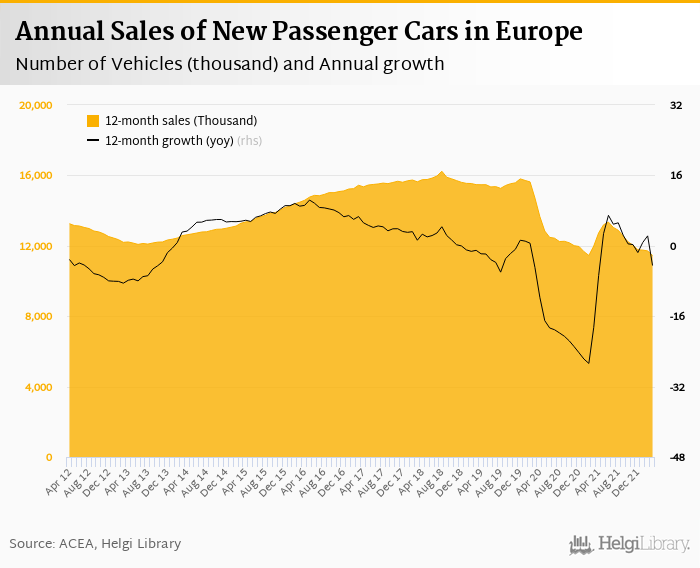
In March, most vehicles (243 thousand) were sold in the United Kingdom (down 14.3% yoy), followed by Germany (241 thousand, down 17.5%), France with 147 thousand cars (down 19.5%), 119 thousand new vehicles were registered in Italy (down 29.6%) and 59.9 thousand in Spain (down 30.2%). The five largest countries accounted for 66.7% of total new vehicles registered in March 2022.
In absolute terms, the best performance in sales of new cars has been seen in Ireland (up 3.67 thousand cars) and Romania (up 3.16 thousand cars). At the other end of the scale, Germany and Italy showed the weakest change in registration of new cars in March when compared to last year (down 51.0 thousand and down 50.2 thousand cars, respectively).
In relative terms, sales in Iceland (+51.6%) and Romania (+40.2%) performed the best compared to a year ago, whereas registration in Sweden and Denmark the worst (-39.5% and -38.4% yoy), in March 2022, according to ACEA:


In the first three months of the year, some 2,754 thousand cars were sold in Europe, down 10.6% yoy. The table below shows details of the sales for each of the European country:
| Country | March 2022 | March 2021 | YOY Change % | 1-3/2022 | 1-3/2021 | YOY Change % |
|---|---|---|---|---|---|---|
| Austria | 20.7 | 29.5 | -30.1 | 52.4 | 63.5 | -17.5 |
| Belgium | 37.0 | 45.0 | -17.7 | 103 | 119 | -13.5 |
| Bulgaria | 2.70 | 2.16 | 25.2 | 6.67 | 5.58 | 19.5 |
| Croatia | 3.81 | 4.15 | -8.17 | 9.63 | 10.5 | -7.98 |
| Cyprus | 0.848 | 0.964 | -12.0 | 3.06 | 2.70 | 13.3 |
| Czechia | 16.9 | 20.1 | -15.7 | 47.4 | 49.5 | -4.33 |
| Denmark | 14.6 | 23.7 | -38.4 | 34.2 | 43.9 | -22.0 |
| Estonia | 2.06 | 2.12 | -2.74 | 5.19 | 5.73 | -9.38 |
| Finland | 7.54 | 10.4 | -27.7 | 21.7 | 28.0 | -22.3 |
| France | 147 | 183 | -19.5 | 365 | 442 | -17.3 |
| Germany | 241 | 292 | -17.5 | 626 | 656 | -4.65 |
| Greece | 8.41 | 8.98 | -6.39 | 22.5 | 23.4 | -4.09 |
| Hungary | 11.2 | 12.4 | -10.3 | 28.7 | 32.2 | -10.9 |
| Iceland | 1.45 | 0.957 | 51.6 | 3.15 | 2.18 | 44.9 |
| Ireland | 12.9 | 9.23 | 39.8 | 49.9 | 48.2 | 3.66 |
| Italy | 119 | 170 | -29.6 | 338 | 447 | -24.3 |
| Latvia | 1.39 | 1.38 | 0.945 | 3.68 | 3.44 | 6.91 |
| Lithuania | 2.35 | 3.07 | -23.5 | 6.50 | 7.61 | -14.6 |
| Luxembourg | 4.34 | 4.97 | -12.7 | 11.3 | 12.5 | -8.90 |
| Netherlands | 25.0 | 24.2 | 3.20 | 78.8 | 81.2 | -3.00 |
| Norway | 16.2 | 15.3 | 5.99 | 32.3 | 36.3 | -10.9 |
| Poland | 39.5 | 47.8 | -17.4 | 102 | 118 | -13.4 |
| Portugal | 13.4 | 12.7 | 5.29 | 34.8 | 31.0 | 12.0 |
| Romania | 11.0 | 7.86 | 40.2 | 29.0 | 20.8 | 39.6 |
| Slovakia | 7.48 | 6.54 | 14.3 | 19.2 | 15.4 | 24.8 |
| Slovenia | 4.63 | 7.07 | -34.5 | 12.8 | 16.3 | -21.7 |
| Spain | 59.9 | 85.8 | -30.2 | 164 | 186 | -11.6 |
| Sweden | 28.7 | 47.5 | -39.5 | 69.7 | 90.9 | -23.3 |
| Switzerland | 21.7 | 25.2 | -13.9 | 54.2 | 56.5 | -4.02 |
| United Kingdom | 243 | 284 | -14.3 | 418 | 426 | -1.87 |
| EU + EFTA | 1,127 | 1,388 | -18.8 | 2,754 | 3,081 | -10.6 |
Volkswagen Group sold the most cars in March 2022 in Europe, some 257 thousand vehicles representing 22.8% of the European market. Sales of PSA Group amounted to 150 thousand vehicles (or 13.3% of the market) while Hyundai Group and Renault Group held 9.60% and 8.40% of the European market in March. Overall, the five largest manufacturers sold 61.2% of all new cars in March:


When compared to last year, Hyundai Motor Company has gained the most in terms of market share rising its market position by 2.58 bp, followed by Toyota Motor Corporation (up 0.949 bp) and Renault (up 0.376 bp). PSA Peugeot Citroen were on the other end of the market spectrum dropping 1.85 bp on the market alongside with Volkswagen Group (down 1.32 bp) and Fiat Chrysler Automobiles (-0.850 bp):

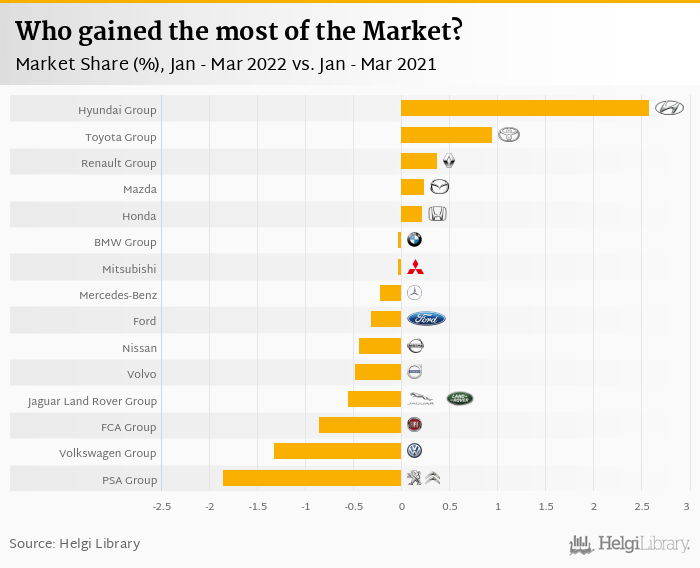
In terms of particular brands, Volkswagen stands out as the most favorite brand accounting for 268 thousand sold vehicles, or 9.72% of all new passenger cars sold on the European market in March 2022.
In terms of momentum, Kia gained the most in terms of market share in the first month of the year 2022 (up 1.58 bp) followed by Hyundai and Toyota. Volkswagen and Peugeot were on the other end of the market spectrum losing -1.09 bp and -1.06 bp respectively:


Volkswagen Group sold 257 thousand new passenger cars representing a 22.8% share of all new passenger cars sold in Europe in March 2022. This is 24.9% fewer vehicles and a 1.84 pp decrease in market share when compared to last year. Looking back three years, VW's market share was 22.8%.
The Group sold 103 thousand of Volkswagen brand cars in March, followed by 65.2 thousand of Audis and 44.6 thousand of Skodas. Seat sold 33.4 thousand vehicles and Porsche some 9.44 thousand cars in March 2022:


PSA Group sold 150 thousand new passenger cars representing a 13.3% share of all new passenger cars sold in Europe in March 2022. This is 29.4% fewer vehicles and a 2.00 pp decrease in market share when compared to last year. By comparison, the market share three years ago stood at 16.1% and is down by 2.80 pp now.
The Group sold 60.7 thousand of Peugeots cars, followed by 44.8 thousand of Opels and 39.2 thousand of Citroens in March 2022:


BMW Group sold 79.9 thousand new passenger cars representing a 7.09% share of all new passenger cars sold in Europe in March 2022. This is 22.9% fewer vehicles and a 0.378 pp decrease in market share when compared to last year. Compared to three years ago, BMW Group's market share is now 0.305 pp higher.
The group sold 64.2 thousand of BMW brand cars, followed by 15.7 thousand of Minis in March 2022:


Hyundai Group sold 108 thousand new passenger cars representing a 9.62% share of all new passenger cars sold in Europe in March 2022. This is 9.94% more vehicles and a 2.51 pp increase in market share when compared to last year. Compared to three years ago, Hyundai Group's market share is now 3.19 pp higher.
The group sold 58.9 thousand of Kia brand cars, followed by of s in March 2022:


Renault Group sold 95.0 thousand new passenger cars representing a 8.43% share of all new passenger cars sold in Europe in March 2022. This is 12.4% fewer vehicles and a 0.617 pp increase in market share when compared to last year. By comparison, three years ago, Renault Group's market share was 10.2%.
The group sold 54.1 thousand of Renault brand cars in March, followed by 40.3 thousand of Dacias and 0.211 thousand of Ladas:


FCA Group sold 53.7 thousand new passenger cars representing a 4.77% share of all new passenger cars sold in Europe in March 2022. This is 32.8% fewer vehicles and a 0.997 pp decrease in market share when compared to last year. By comparison, three years ago FCA Group's market share stood at 6.05%.
The group sold 38.0 thousand of Fiat brand cars in March, followed by 9.69 thousand of Jeeps and 2.07 thousand of Alfa-Romeos:


Toyota Group sold 74.0 thousand new passenger cars representing a 6.56% share of all new passenger cars sold in Europe in March 2022. This is 10.2% fewer vehicles and a 0.628 pp increase in market share when compared to last year. Toyota Group's market share three years ago, by comparison, stood at 4.67%.
The group sold 69.8 thousand of Toyota brand cars in March, with Lexus following at 4.13 thousand cars:


Jaguar Land Rover Group sold 14.1 thousand new passenger cars representing a 1.26% share of all new passenger cars sold in Europe in March 2022. This is 52.0% fewer vehicles and a 0.870 pp decrease in market share when compared to last year. Three years ago however, the market share of Jaguar Land Rover Group was 2.05%.
The group sold 10.5 thousand of Land Rovers in March, followed by 3.63 thousand of Jaguars:


Mercedes-Benz sold 68.3 thousand new passenger cars representing a 6.06% share of all new passenger cars sold in Europe in March 2022. This is 23.6% fewer vehicles and a 0.385 pp decrease in market share when compared to last year. By comparison, three years ago, Mercedes-Benz's market share was 6.04%.
The group sold 65.5 thousand of Mercedes in March, followed by 2.84 thousand of Smart cars:


Ford sold 56.5 thousand new passenger cars representing a 5.01% share of all new passenger cars sold in Europe in March 2022. This is 18.0% fewer vehicles and a 0.047 pp increase in market share when compared to last year. Compared to three years ago, Ford's market share is now 1.51 pp lower.

Volvo sold 26.9 thousand new passenger cars representing a 2.39% share of all new passenger cars sold in Europe in March 2022. This is 34.1% fewer vehicles and a 0.556 pp decrease in market share when compared to last year. Compared to three years ago, Volvo's market share is now 0.291 pp higher.

Nissan sold 27.4 thousand new passenger cars representing a 2.43% share of all new passenger cars sold in Europe in March 2022. This is 30.7% fewer vehicles and a 0.417 pp decrease in market share when compared to last year. Compared to three years ago, Nissan's market share is now 0.681 pp lower.

Mazda sold 16.7 thousand new passenger cars representing a 1.48% share of all new passenger cars sold in Europe in March 2022. This is 0.482% fewer vehicles and a 0.273 pp increase in market share when compared to last year. Compared to three years ago, Mazda's market share is now 0.136 pp lower.

Mitsubishi sold 5.54 thousand new passenger cars representing a 0.492% share of all new passenger cars sold in Europe in March 2022. This is 30.0% fewer vehicles and a 0.078 pp decrease in market share when compared to last year. Compared to three years ago, Mitsubishi's market share is now 0.589 pp lower.

Honda sold 7.36 thousand new passenger cars representing a 0.653% share of all new passenger cars sold in Europe in March 2022. This is 7.21% more vehicles and a 0.158 pp increase in market share when compared to last year. Compared to three years ago, Honda's market share is now 0.420 pp lower.
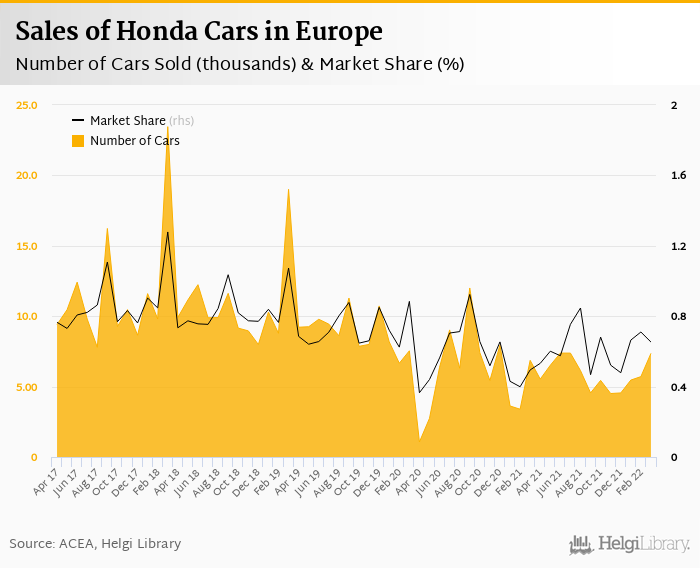
Based on a comparison of 64 countries, China ranked the highest with 20,178 thousand passenger cars sold in 2020 followed by Japan and the USA. Total sales of passenger cars reached 53,599 thousand in 2020 in the world, according to ACEA. This is 15.9% less than in the previous year and 3.98% less than 10 years ago. Historically, total sales of passenger cars reached an all time high of 70,695 thousand in 2017 and an all time low of 11,000 thousand in 1961. The average annual growth stands at 2.39% since 1960.
The top ranked country, China, accounted for 37.6% of all passenger cars sold in the world. The top 3 countries held a 51.1% share while the ten largest countries some 75.9% in 2020.
China was the largest car producer in 2020 with 19,994 thousand followed by Japan and Germany. Total production of passenger cars reached 55,834 thousand in 2020 in the world, according to ACEA. China accounted for 35.8% of the world's production, while the top 3 countries held a 54.6% share and the ten largest countries some 79.3% in 2020:
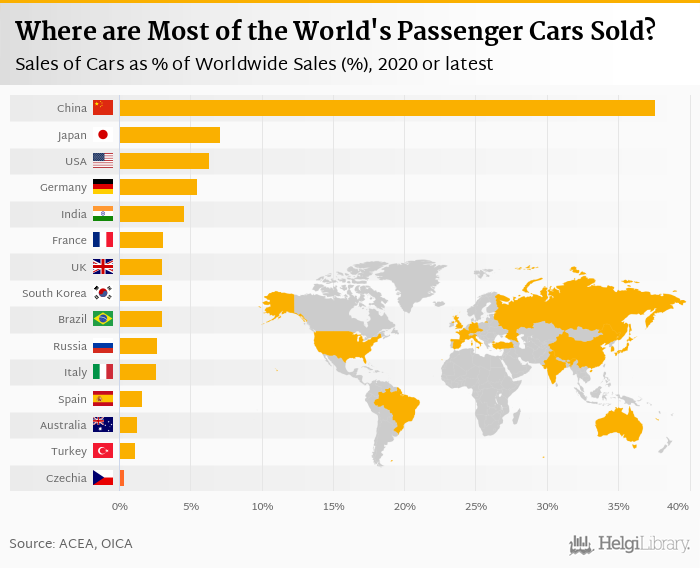

Based on a comparison of 29 countries, Germany ranked the highest in sales of electric cars with 395 thousand followed by France and United Kingdom in 2020. When looking at the ratio of electric to total new cars sold, Norway ranked the highest with 74.8% followed by Iceland and Sweden:

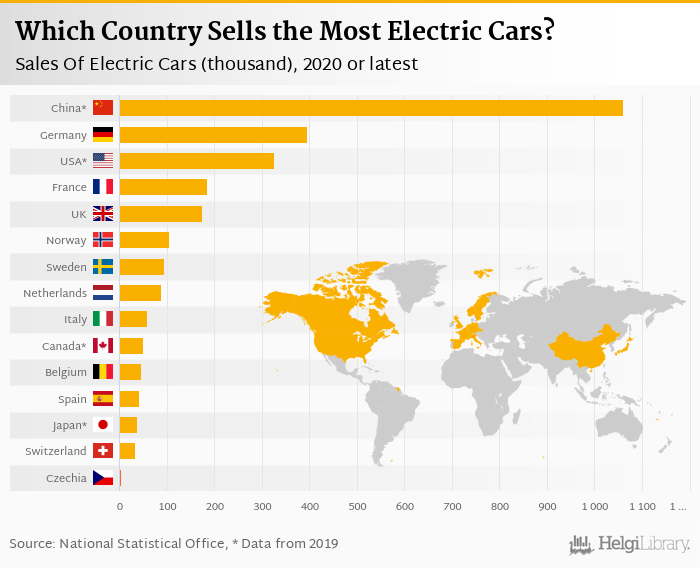
By contrast, Bulgaria ranked the highest in the number of petrol-fuelled as a proportion of new cars sold with 84.7%, followed by Cyprus and Slovenia. In terms of diesel-fuelled vehicles, Ireland ranked the highest with 33.5% followed by Croatia and Luxembourg:


In 2016, Switzerland ranked the highest in 4x4 drive cars as a share of new cars sold with 42.1% followed by Norway and Sweden. Switzerland ranked the highest in the average power of new cars sold with 122 kW followed by Luxembourg and Sweden:


Based on the latest available data, Lithuania, Estonia and Romania were the countries with the oldest average age of passenger cars. The average age was an ancient 16.8 years in Lithuania, 16.7 years years for Estonia and 16.5 years years in Romania. On the other end of the scale was Austria with 8.30 years years, the United Kingdom with 8.00 years years and Luxembourg with 6.50 years years.

Based on a comparison of 27 firms among Global Car Producers, Volkswagen Group generated the highest sales in 2019 followed by Toyota Motor Corporation and Daimler Group. At the same time, Toyota Motor Corporation had the highest market value followed by Volkswagen Group and Tesla Inc.:


Volkswagen Group generated the highest earnings before interest costs, taxes and depreciation (so called EBITDA) in 2019 followed by Toyota Motor Corporation and General Motors. At the same time, Ferrari generated the highest EBITDA Margin followed by Porsche AG and BMW Group.


Ferrari produced the highest net profit per car sold in 2019 followed by Porsche AG and Toyota Motor Corporation. Ferrari made a net profit of USD 77,831 for each car sold, down 21.7% compared to the previous year.
